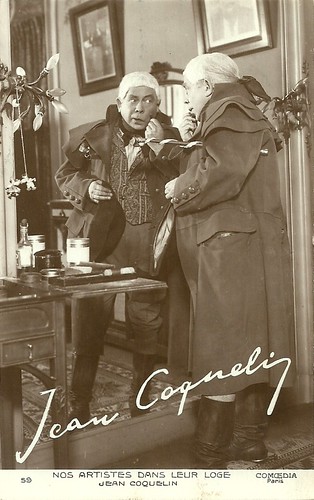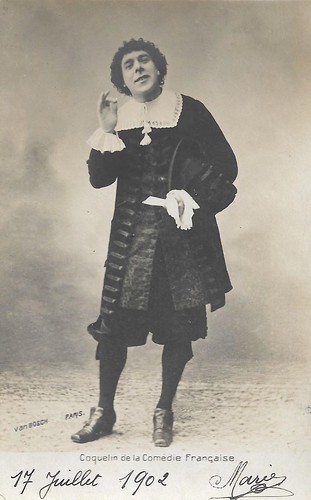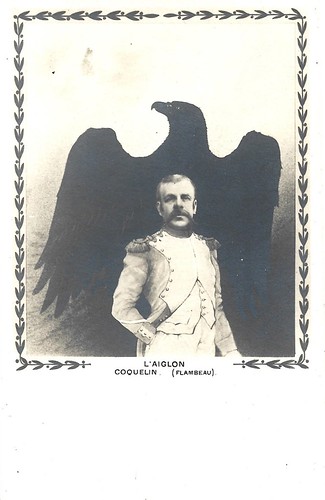
French postcard in the 'Nos artistes dans leur loge' series, no. 59. Photo: Comoedia, Paris.

French postcard, signed and dated 17 July 1902. Photo: Van Bosch, Paris. Caption: Coquelin de la Comédie Française.

French postcard. Jean Coquelin as Flambeau in the play 'L'aiglon' by Edmond Rostand.
A debut at the Comédie Française
Jean Coquelin was born Camille Léon Jean Coquelin in 1865 in Paris, France. He was the son of the stage actor Benoit Constant Coquelin also known as Coquelin ainé and actress Antoine Mancy. His uncle, Coquelin Cadet, was also well-known actor.
He studied with Mme Arnould Plessy and Coquelin aîné, his father. He followed the latter on a major tour of Europe, and then entered the Comédie Française in 1890. He made his debut in 'Le Dépit amoureux', then played in 'Thermidor' and 'La Mégère apprivoisée'. He then moved on to the Renaissance Theatre.
In 1907, he became co-director of the Théâtre de la Gaité alongside Henry Hertz in 1907. In 1910, he and Hertz became the directors of the Théâtre de la Porte Saint-Martin, when Edmond Rostand's 'Chantecler' premiered there. That year, he married Blanche Miroir on 18 May 1910 in Neuilly sur Seine. His witnesses were Edmond Rostand and Albert Carré, and the bride's witnesses were Henry Hertz and Mme Michel.
At the Porte Saint-Martin, hee created the character of Raigoné in Edmond Rostand's 'Cyrano de Bergerac', the major play in which his father had performed.
Coquelin and his father played together in the stage play 'La Dame de Monsoreau', after a novel by Alexandre Dumas, turned into a stage play in 1860.

French postcard by ELD, no. 84. Jean Coquelin as the farmyard dog Patou in 'Chantecler', a play by Edmond Rostand.

French postcard by ELD / GPL. Photo: Bert. Jean Coquelin as the farmyard dog Patou in 'Chantecler', a play by Edmond Rostand.
Clergyman
In 1925, after years of theatre performances, Jean Coquelin started to appear in film too. He made his debut in the lead role of the comedy Abbé Constantin/The Abbot Constantine (Julien Duvivier, 1925) with Claude France. He often played a clergyman such as the priest in La Roche aux Mouettes (Georges Monca, 1933).
Coquelin played several times with Julien Duvivier in such films as David Golder (Julien Duvivier, 1930) starring Harry Baur and La fin du jour/The End of the Day (Julien Duvivier, 1939) with Victor Francen and Michel Simon.
He even played more often with director Sacha Guitry and appeared in his films Faisons un reve/Let's Make a Dream (Sacha Guitry, 1937), Les perles de la couronne/The Pearls of the Crown (Christian-Jaque, Sacha Guitry, 1937), Remontons Les Champs-Elysées/Let's Go Up the Champs-Élysées (Sacha Guitry, Robert Bibal, 1938) and Le destin fabuleux de Désirée Clary/Mlle. Desiree (Sacha Guitry, 1942).
After his debut in a lead role, most of his roles were secondary characters or bit parts. His last role was a bit part in Maurice Tourneur's Les mains du diable/The Devil's Hand (Maurice Tourneur, 1943) with Pierre Fresnay, after the novel by Gérard de Nerval.
Jean Coquelin died in 1944 in Couilly-Pont-aux-Dames, Seine-et-Marne, France. He was 78. Coquelin was married to 'Blanche Miroir' and actress Louise Didès. With Didès, he had a son, actor Jean-Paul Coquelin.

French postcard by Eclair. Photo: Atelier Nadar. Caption: Porte St. Martin. Jean Coquelin in the play 'La Dame de Monsoreau' (1908).

French postcard. Jean Coquelin as Flambeau in the play 'L'aiglon' by Edmond Rostand.
Sources: Theatredatabase, Wikipedia (French and English) and IMDb.
No comments:
Post a Comment